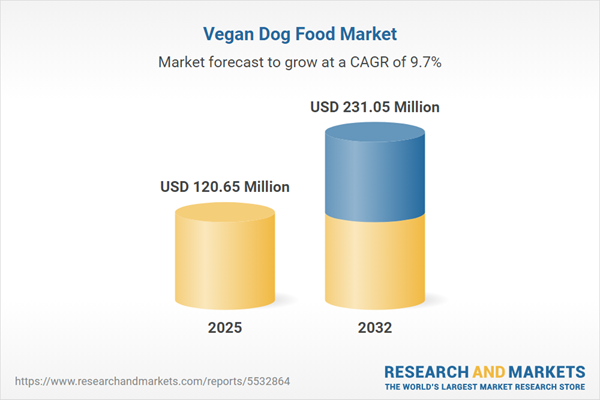Speak directly to the analyst to clarify any post sales queries you may have.
The Vegan Dog Food Market is experiencing robust expansion, propelled by rising consumer demand for health-focused and environmentally responsible pet nutrition. As sustainability and animal welfare become priority concerns, the market for plant-based canine diets is transitioning from a niche category to a significant growth opportunity for manufacturers and investors alike.
Market Snapshot: Vegan Dog Food Market Growth and Outlook
The vegan dog food market grew from USD 110.14 million in 2024 to USD 120.65 million in 2025. Ongoing market trends project a CAGR of 9.70%, with anticipated revenues reaching USD 231.05 million by 2032. This momentum underscores strong investor confidence and signals consistent demand across global markets. Drivers include increasing awareness of pet health, the adoption of sustainable solutions, and notable product innovation that outpaces traditional pet nutrition segments.
Scope & Segmentation of the Vegan Dog Food Market
This report delivers granular insights into market structure, consumer behavior, and innovation trends influencing vegan pet food adoption. Market coverage extends across all key segmentation dimensions, providing senior leaders with actionable intelligence for market positioning and growth.
- Product Forms: Dry, treats, and wet formulations, each serving distinct feeding needs and customer segments.
- Protein Sources: Pea, potato, rice, and soy proteins, allowing alternatives for allergenic or dietary requirements.
- Distribution Channels: Online retail (direct-to-consumer, third-party platforms), pet specialty stores (physical and digital), supermarkets and hypermarkets, and veterinary clinics (including clinic pharmacy and digital portals).
- Age Groups: Adult, puppy, and senior, each with differentiated formulas designed to meet specific health and nutritional requirements.
- Regional Coverage: Americas (North and Latin America), Europe, Middle East & Africa, and Asia-Pacific, tailored to varied consumer profiles, infrastructure, and regulatory frameworks.
The analysis also highlights advances in ingredient technology—such as fermentation, precision extrusion, and enrichment with botanical extracts—addressing both nutritional completeness and sensory quality for canine consumers.
Key Takeaways for Senior Decision-Makers
- Plant-based dog food is gaining traction as a mainstream choice, reflecting shifting owner attitudes toward health and sustainability.
- Ingredient innovation enables vegan formulations to address essential nutritional requirements, responding to concerns over amino acid profiles and palatability.
- Growth is supported by a combination of digital commerce development, targeted product ranges, and expanding distribution, with online and specialty channels rapidly gaining ground over traditional retail.
- Leading brands are differentiating through exclusive ingredient partnerships, adoption of sustainable packaging, and advanced product certification strategies to support trust among discerning pet owners.
- Regional variations—such as regulatory initiatives in Europe or digital infrastructure improvements in Asia-Pacific—are shaping local adoption and channel mix.
- Specialized formulations for different life stages and health outcomes broaden the addressable market and foster resilience amid competitive and regulatory shifts.
Impact of United States Tariff Adjustments (2025)
Upcoming changes to U.S. import duties on select plant-based protein sources and additives are expected to reshape sourcing, costing, and supply chain strategies. Some manufacturers will seek domestic alternatives or absorb cost pressures, while others anticipate adjusting end-user pricing or streamlining operations. Strategic responses, such as vertical integration or local partnership development, are expected to aid risk mitigation and supply resilience in a dynamic regulatory environment.
Primary and Secondary Research Methodology
The findings integrate extensive interviews with veterinarians, industry executives, and nutritionists, supported by analysis of peer-reviewed journals, market intelligence repositories, and recent regulatory documentation. Quantitative and qualitative data were validated using triangulation and scenario modeling to ensure comprehensive and reliable insights for strategic planning.
Why This Report Matters: Actionable Insights for Investors and Industry Leaders
- Informs product innovation and strategic investments by elucidating market shifts, consumer priorities, and emerging technologies specific to the vegan dog food sector.
- Offers clear guidance on adapting to regulatory and trade changes, including the impact of tariffs and sustainability mandates on market entry and supply chain operations.
- Supports effective go-to-market strategies by outlining distribution trends and regional growth drivers, empowering decision-makers to optimize resource allocation and maximize competitive advantage.
Conclusion
The vegan dog food market is poised for sustained growth, with innovation in product development, technology adoption, and channel strategies shaping future competitiveness. Industry stakeholders attuned to evolving regulatory dynamics and consumer expectations will be well-positioned to capitalize on emerging opportunities in this transformative sector.
Additional Product Information:
- Purchase of this report includes 1 year online access with quarterly updates.
- This report can be updated on request. Please contact our Customer Experience team using the Ask a Question widget on our website.
Table of Contents
3. Executive Summary
4. Market Overview
7. Cumulative Impact of Artificial Intelligence 2025
Companies Mentioned
The companies profiled in this Vegan Dog Food market report include:- V-Dog, LLC
- Wild Earth, Inc.
- Benevo Pet Foods Limited
- Ami Pet Foods Pty Ltd.
- Vegepet Pty Ltd.
- Halo, Purely for Pets, Inc.
- Petaluma Pet & Livestock Supply, Inc.
- Sprout Pet Products LLC
- Yarrah Organic Petfood B.V.
- Lily’s Kitchen Ltd.
Table Information
| Report Attribute | Details |
|---|---|
| No. of Pages | 193 |
| Published | October 2025 |
| Forecast Period | 2025 - 2032 |
| Estimated Market Value ( USD | $ 120.65 Million |
| Forecasted Market Value ( USD | $ 231.05 Million |
| Compound Annual Growth Rate | 9.7% |
| Regions Covered | Global |
| No. of Companies Mentioned | 11 |









